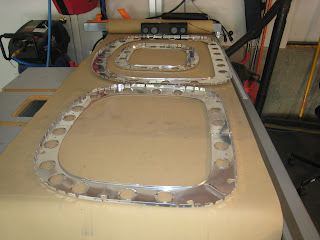This weekend was much more fun, after a bit of final priming I assembled the horizontal stabilator frame.
Most of the assembly is very straightforward, although you do have to pay careful attention to which rivet to use where, there's some flush pop rivets as well as the regular AN426 countersunk rivets, and also some AN470-AD-4 solid rivets.
I found that the CS4-4 countersunk pop rivet shanks get stuck in the pneumatic rivet puller when being ejected, and so I pulled all those with the hand tool.
The AN426-AD-3 rivets were all set with the hand squeezer, but the AN470-AD-4 rivets are MUCH harder to squeeze, and it's another one of those jobs that requires more arms than I happen to have attached, so I really wanted to use the pnuematic squeezer on those, and there lies this tale:
Here's a little bit of the story that happened during the week.
I had been having trouble with my pneumatic squeezer, it has never worked properly since I bought it for the project in April. Having never owned or operated one before, I wasn't sure if it was faulty, or if it was just my limited experience and poor technique.
I tried to use it for a few rivets on the hinges of the VS, the first part of the kit, but everything was so new to me, I had no idea what was working properly and what wasn't and that part of the kit only used the smaller AN*-AD-3 rivets so up until now I have been using my hand squeezer, which has been working very well, so well in fact that I was now convinced that the pneumatic squeezer was defintely not operating properly.
So I downloaded the latest manual, read it all and took note of the "bleeding procedures"; This particular squeezer is hydraulic just like a car brake system, and even though it is new and shouldn't need maintenance I thought I would give that a try.
Well, as you can imagine, it's a messy job that is designed for people with at least 4 arms which I was unfortunate enough not to be born with, but I did manage to get it done. Once I got it set all up again I tried a rivet, and it was exactly the same as before, just not enough power or travel to properly squeeze a rivet.
Oh, well I decided to return it, and hoped that I could get my money back, I emailed cleveland and they were very helpful and offered to take the unit back for a full refund, nice.
But it was bothering me that I couldn't figure this out, it was a well made expensive unit, why would it function so poorly?, I decided to call the manufacturer, actually I sent email, and they replied almost immediately and were very helpful, offered suggestions on more bleeding and a few other tips, but also said they would have no problem replacing the unit, send it to them directly and they would examine it and figure out what was wrong, I got a very good vibe from them, so decided to give it another go.
So, first thing Saturday morning, I got out the paper towels ready for the mess, and determined to really do this job properly, followed the instructions to the letter, exactly 1 1/2 turns of the valves, as much height as possible for the head over the base unit and this time I pumped the oil through over and over, 8 syringes full.
I didn't see any air escape and so I expected the same poor performance, but wow what a difference, it worked superbly, this is now my favorite tool of the whole job, it squeezed the AN470-AD-4 rivets perfectly with no noticeable effort at all.
I'm glad I stuck with it and sent a note of thanks to the manufacturer for their help.
So, that put me in a good mood and I assembled everything except the skins of the HS which still need priming, and are too big to fit in my "paint tent". It was extremely windy this weekend, so no chance of painting them outside either, so that will have to wait.
I am very happy with the HS, this really looks like a proper airplane part !

















































